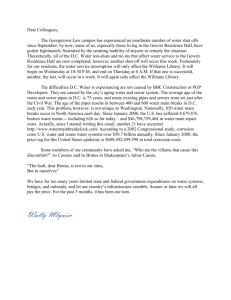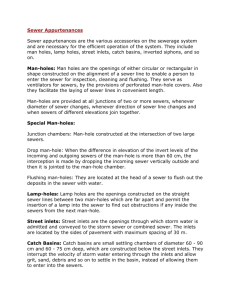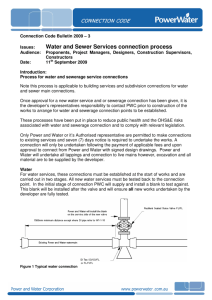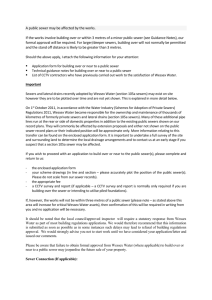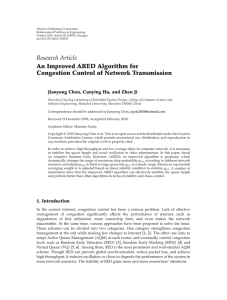Sewerage System
advertisement
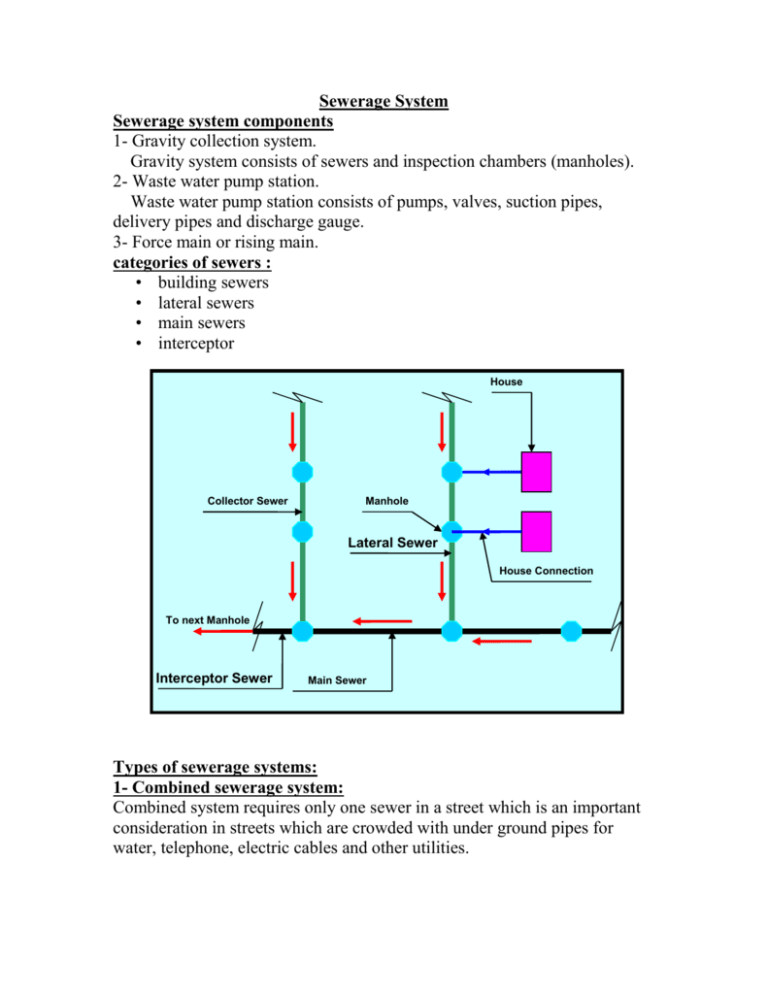
Sewerage System Sewerage system components 1- Gravity collection system. Gravity system consists of sewers and inspection chambers (manholes). 2- Waste water pump station. Waste water pump station consists of pumps, valves, suction pipes, delivery pipes and discharge gauge. 3- Force main or rising main. categories of sewers : • building sewers • lateral sewers • main sewers • interceptor House Collector Sewer Manhole Lateral Sewer House Connection To next Manhole Interceptor Sewer Main Sewer Types of sewerage systems: 1- Combined sewerage system: Combined system requires only one sewer in a street which is an important consideration in streets which are crowded with under ground pipes for water, telephone, electric cables and other utilities. 2- Separate sewerage system: It is used in rainy cities which the quantities of domestic wastewater in only a small fraction of the storm water. A comparison between the combined system and the separate system Combined system Separated system Small quantity of rain large quantity of rain Narrow streets Wide streets The land is flat The land had a great slops Concentrated wastewater A near place for disposal is available The design criteria of sewers: 1- Sewers should run partially full. Sewers of diameter ≤ 375 mm run ½ full. Sewers of diameter › 375 mm and ≤ 700 mm run 2/3 full. Sewers of diameter › 700 mm run 3/4 full. 2- Maximum velocity in sewers should not exceed the velocity that damages the sewer which is 2 m/s. 3- Minimum velocity in sewers should not go below 0.45 m/s. 4- Minimum cover should not be less than 1.2 m. 5- Maximum excavation should not exceed 5 – 7m depend on the type of soil. 6- Minimum diameter of sewer is 7” and preferably 8”. Types of sewers material: Sewer type Diameter (mm) Glass vitrified clay G.V.C 175 – 900 U.P.V.C 200 – 700 Polly ethylene high density 200 – 700 G.R.P 200 – 2800 Ductile cast iron 200 – 900 Pre-cast concrete 600 – 3000 Sewer used in sewerage system Sewer type Sewer usage Glass vitrified clay G.V.C – U.P.V.C House connection Polly ethylene high density Glass vitrified clay G.V.C – U.P.V.C - Lateral sewer Polly ethylene high density – G.R.P – reinforced concrete Main sewer G.R.P – reinforced concrete Collector – interceptor Ductile cast iron - GRP –pre-stressed Force main concrete Ductile cast iron - steel Pipes in pump station Ductile cast iron - steel Pipes in valves room Ductile cast iron - steel Pipes between wastewater treatment plant's units The design flow rates of the sewerage system: Sewage factor = 0.8 – 0.9. Qave = (0.8 – 0.9) qave x population. Qave summer = (1.2 – 1.3) Qave Qave winter = (0.7 – 0.8) Qave Qmax summer = P.F.F x Qave summer + Qinf Qmax winter = P.F.F x Qave winter + Qinf + QR Qmin winter = M.F.F x Qave winter + Qinf + QR 14 pop 4 1000 For population > 80000 5 population 0.2 ( ) 1000 For population ≤ 80000 P.F. F. 1 P. F.F. pop M. F.F. 0.2 1000 0.167 Qinf m d Y m3 / day/km m = coefficient depends on sewer types and age. = 0.2 – 0.5 for cast iron. = 1 – 10 for G.V.C d = diameter in inches. Y = depth of water above the center line of the sewer Qinf = 15% of Qave Qrain ( A 10 4 ) I (mm / d ) I (mm / d ) R ( A 10 4 ) R 1000 1000 I = intensity of rain (mm/day) R= run off factor = ½ - 1/3 for roods. = 1/6 – ¼ for roves. A= area in hectares Hydraulic design of sewerage system The equations used in the design of sewers: 1- Q = Awet x v discharge equation 2- v = 1/n R2/3 S1/2 Manning equation v: velocity n: coefficient of roughness (n=0.012 – 0.15) R: hydraulic radius (R = Awet/pwet) S: slope (s=h/l) 3- v = 0.849 x C x R0.64 x S0.54 Hazen William equation Chart (1) In this chat we must use Qfull or vfull. We can’t use this chart to get Qmax, Qmin, vmax, and vmin. We have to have two parameters to get the other two parameters. Chart (1) Chart (2) In this chart if we know one parameter we can get the other two parameters . Example: A circular sewer carries 50 l/s when the sewer is full, and the flow is running 2/3 full, S = 3%◦. Determine the minimum velocity and depth of flow. Solution: From chart (1): Qfull = 50 l/s , S = 3%◦ =12’’, vfull = 0.68 m/s From chart (2): d 2 d full 3 d = 2/3 x 12” = 8” = 8 x 2.54 = 20.32 cm v v full 1.08 V = 0.68 x 1.08 = 0.73 m/s Inspection chambers (manholes) Location of manholes: 1- Change in slope 3- Intersections of sewers ` 2- Change in direction 4- Change in diameter 5- In case of steep slope 6- at regular distance depends on sewer diameter ” Distance (m) 8 30 10 40 12 – 16 50 18 – 36 60 36 – 48 100 ›48 150


